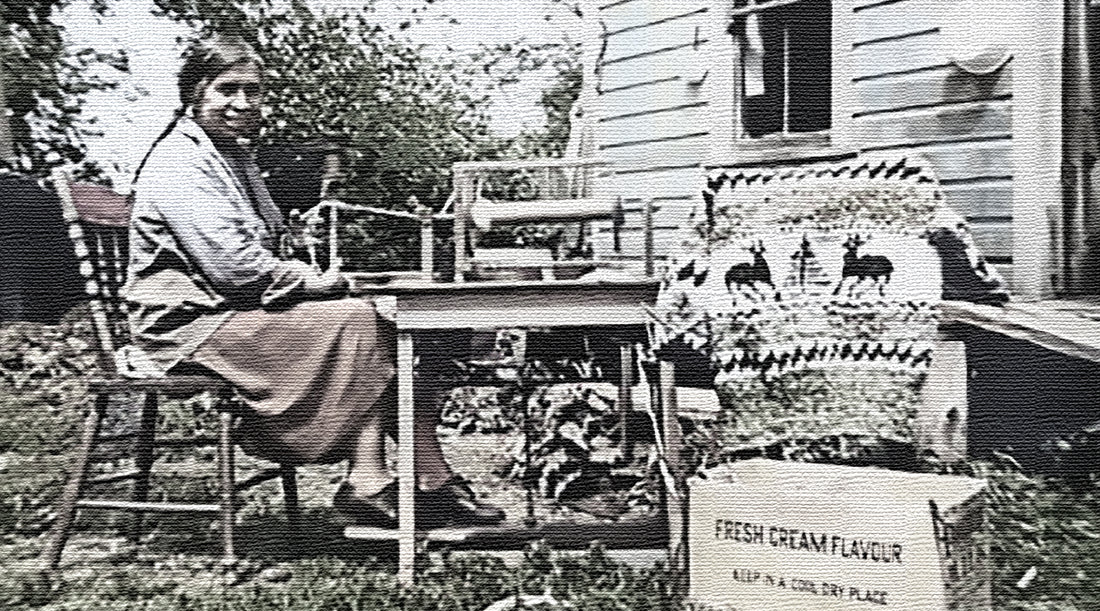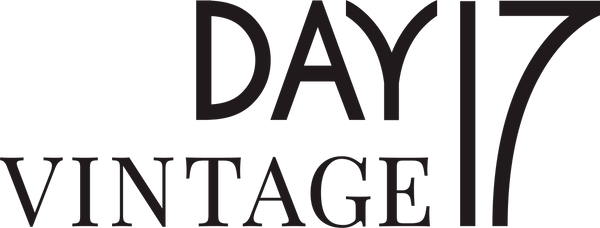
The Cowichan Sweater: Cultural Collaboration Creates Iconic Style
Share
 A typical Cowichan sweater design
A typical Cowichan sweater designWhat does “Cowichan" mean?
Cowichan sweaters take their name from the Cowichan Valley on southern Vancouver Island, still a relatively rural area where bald eagles are plentiful, herds of elk roam free, and the salmon return to the local rivers each year to spawn. View of the Cowichan River estuary
View of the Cowichan River estuary
The name is an Anglicization of the First Nations tribal name Quw’utsun, which translates roughly to “warm place”. And the Cowichan valley is indeed a warm place, boasting Canada’s warmest average temperatures and a maritime Mediterranean climate that supports a thriving agricultural industry, including numerous vineyards. While the area is relatively warm and mild, it is also very wet, with an average of 75 days and 60 inches / 150 cm of rain yearly.
Cowichan sweaters have also historically been referred to as Siwash sweaters. The word Siwash is borrowed from Chinook, the pidgin trade language of the Pacific Northwest. This language was used all the way from Oregon up to Alaska, and borrowed words from the indigenous Chinook language, as well as English and French. The term Siwash is thought to have come from the French word “sauvage”, meaning wild, and therefore carries somewhat negative connotations today. So we’ll stick with Cowichan.
The History of Cowichan Knitting
Like many other art forms practiced by women or minority groups, Cowichan knitting didn’t receive a lot of attention until it could be commercialized on a larger scale. So while it’s difficult to provide exact dates for the origins of Cowichan knitting, I can offer a general timeline of its development.
Archeological evidence reflects the presence of First Nations groups in the Pacific Northwest stretching back almost 14,000 years. Like all of the region’s indigenous groups, the Cowichan people already had a highly developed textile tradition at the time of contact with Europeans. They were highly skilled at crafting textiles from locally available materials such as cedar bark, mountain goat hair, and the wool from small dogs. They were accomplished spinners, weavers and basket makers, producing technically complex and astonishingly beautiful items for ceremonial as well as everyday use.
 Cowichan girl in woven blanket, 1913 photo by Edward Curtis
Cowichan girl in woven blanket, 1913 photo by Edward Curtis
But the technique of knitting, and the use of sheep’s wool, was introduced when European settlers and missionaries arrived in the Cowichan Valley in the mid-1800s. Sheep were brought in and the Sisters of St. Ann established a school for the native population in 1864. They taught the Cowichan women to knit socks and mitts using seamless construction techniques that would later become one of the hallmarks of a genuine Cowichan sweater.
 St. Ann's church and rectories at the base of Mt. Tzouhalem, 1914 postcard
St. Ann's church and rectories at the base of Mt. Tzouhalem, 1914 postcard
The earliest Cowichan garments were knit all in one color. This changed when a Scottish settler from the Shetland Islands, Jerimina Colvin, settled in the Cowichan Valley in 1885 and brought the Fair Isle knitting techniques of her homeland with her. The Cowichan women combined these stranded knitting techniques, the local undyed sheep’s wool, and their own motifs to create a truly unique style of knitwear.

Features of Cowichan Sweaters
So what are the distinctive characteristics of these iconic Cowichan knits? Key features include:- Pure Wool Material: They are typically hand-knit from thick, unspun or lightly spun single ply wool yarn, providing excellent warmth and insulation. The wool is minimally processed and retains much of its lanolin, making the finished garment surprisingly water repellent (perfect for the rainy Cowichan Valley).
- Distinctive Motifs: Cowichan sweaters are known for their striking and culturally significant designs. These often feature indigenous motifs and patterns, including animals (e.g., eagles, bears, or orcas), totemic symbols, and traditional geometric patterns. Each sweater is unique, and the patterns can convey cultural and personal stories.
- Chunky and Oversized: Cowichan sweaters tend to be oversized and chunky in appearance. They have a very distinctive cardigan style with a zipper front and shawl collar. They can be quite heavy due to the thick yarn which provides extra insulation.
- Natural Colors: Traditional Cowichan knits are typically made using natural, undyed wool in the regional sheep’s shades of cream, brown, gray, and black. This gives them a rustic and earthy appearance.
- Handcrafted: The sweaters are traditionally hand-knit with a seamless design.
- Functional and Durable: Cowichan knits were originally made for practical purposes, providing warmth and protection against the rainy coastal climate of the Pacific Northwest. They are incredibly durable and can last for many years if well cared for.
- Cultural Significance: Cowichan sweaters hold cultural and historical significance to the Coast Salish people. They are not only functional garments but also works of art that can tell stories, depict traditions, and convey the wearer's identity and personal style.
- Collector's Items: Cowichan sweaters are highly sought after by collectors and those interested in traditional knitwear. They have a timeless and classic appeal. Over time, your sweater will become a heritage piece worth passing on.
Cowichan Knitting Today
In the early 20th century, Cowichan sweaters gained popularity among non-Indigenous people, especially fishermen and loggers working in the Pacific Northwest. As a result, the Cowichan knitting tradition evolved, with many Cowichan women (and their families) developing cottage industries to feed the commercial and tourist markets.
By the mid-20th century, Cowichan sweaters were known around the world, having become an iconic symbol of indigenous Canadian art and culture. They were embraced not only for their practicality but also for the cultural significance and the artistry of their designs. Movie stars, heads of state, and celebrities were photographed wearing them.
Unfortunately for the knitters, who worked long hours for very little pay, it was often the middlemen who profited the most. And then there were the outside companies who were able to capitalize on Cowichan knitting’s popularity with inexpensive machine made knock-offs. By the end of the 20th century, many Cowichan women had given up on knitting as a viable way to make a living.
But recent years have seen a growing interest in traditional craft by Cowichan young people, as across society as a whole. There are an increasing number of initiatives to pass on traditional knowledge and skill, and to help knitters receive fair compensation for their art. Happily, Cowichan knitting never really disappeared.
When we had our small flock of sheep “Lucy and the Ladies“ on Vancouver Island (well guarded by our llama Leroy), I used to give the cleaned and carded wool to the local native knitter Rose J. who was an expert at her craft. She spun and knit all year long. Her house was filled with piles of beautiful finished pieces that gave it a wonderful wooly smell and very warm, cozy atmosphere.
One time she offered to make me a cardigan from my sheep’s wool in grey, off-white and black. When I came to pick it up, she popped open a bulging old leather suitcase with my new sweater on top. It’s in a simple three-colour design, but gorgeous with its rich feel of thick, water-repellent wool. I still wear it every winter with very fond memories of our many years living in this magical valley.
Where to Get Your Own Cowichan Sweater
I was lucky to be able to call the Cowichan Valley home for over twenty years and to have gotten to know Rose. But for those who don’t live on or travel to Vancouver Island, how is it possible to have one of these beautiful creations?
A quick Google search will return dozens of results for sites selling Cowichan sweaters. Many of these are machine made imitations or sweaters that have been produced in an exploitative manner. So why not go directly to the source? The Cowichan Tribes publishes a list of knitters and their contact information. Many of them have completed works for sale or are happy to work with customers on custom projects. It doesn’t get much more fair trade than that!

Knit Your Own Cowichan Sweater Masterpiece
Another wonderful option, if you’re a knitter, is to create your own Cowichan sweater. Finding the appropriate wool can be a little bit challenging, but there are possibilities out there. My wife recently completed an all white Cowichan sweater for our son in Drops Andes and it turned out beautifully… soft, traditional yet modern, and with a lovely drape.
We have many vintage Cowichan sweater patterns in our collection that you can used as-is, or as a template for your own creative expression, which is really what Cowichan knitting is all about.
Happy knitting!

4 comments
I would like to purchase, for my Korean retail shop. Can you quote wholesale price?
I would like to purchase, for my Korean retail shop. Can you quote wholesale price?
I would like to purchase for my whole family. Need 12 pcs can I get price for South Korea.
Great historical article
Is the a place were there is explanation of the patterns on sweaters